Abstract
Previously we demonstrated in rats that chronic hyperkalemia had no effect on ammonium secretion by the proximal tubule in vivo but that high K+ concentrations inhibited ammonium absorption by the medullary thick ascending limb in vitro. These observations suggested that chronic hyperkalemia may reduce urinary ammonium excretion through effects on medullary transport events. To examine directly the effects of chronic hyperkalemia on medullary ammonium accumulation and collecting duct ammonium secretion, micropuncture experiments were performed in the inner medulla of Munich-Wistar rats pair fed a control or high-K+ diet for 7-13 d. In situ pH and total ammonia concentrations were measured to calculate NH3 concentrations for base and tip collecting duct and vasa recta. Chronic K+ loading was associated with significant systemic metabolic acidosis and a 40% decrease in urinary ammonium excretion. In control rats, 15% of excreted ammonium was secreted between base and tip collecting duct sites. In contrast, no net transport of ammonium was detected along the collecting duct in high-K+ rats. The decrease in collecting duct ammonium secretion in hyperkalemia was associated with a decrease in the NH3 concentration difference between vasa recta and collecting duct. The fall in the NH3 concentration difference across the collecting duct in high-K+ rats was due entirely to a decrease in [NH3] in the medullary interstitial fluid, with no change in [NH3] in the collecting duct. These results indicate that impaired accumulation of ammonium in the medullary interstitium, secondary to inhibition of ammonium absorption in the medullary thick ascending limb, may play an important role in reducing collecting duct ammonium secretion and urinary ammonium excretion during chronic hyperkalemia.
Full text
PDF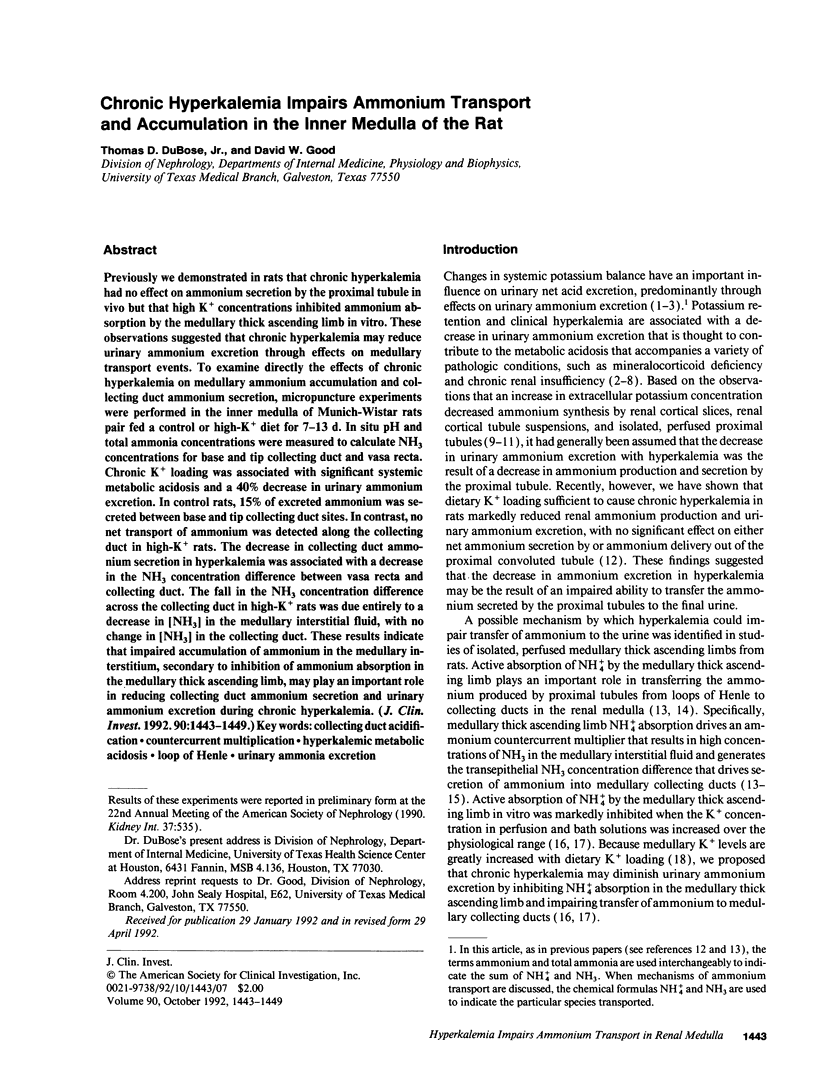
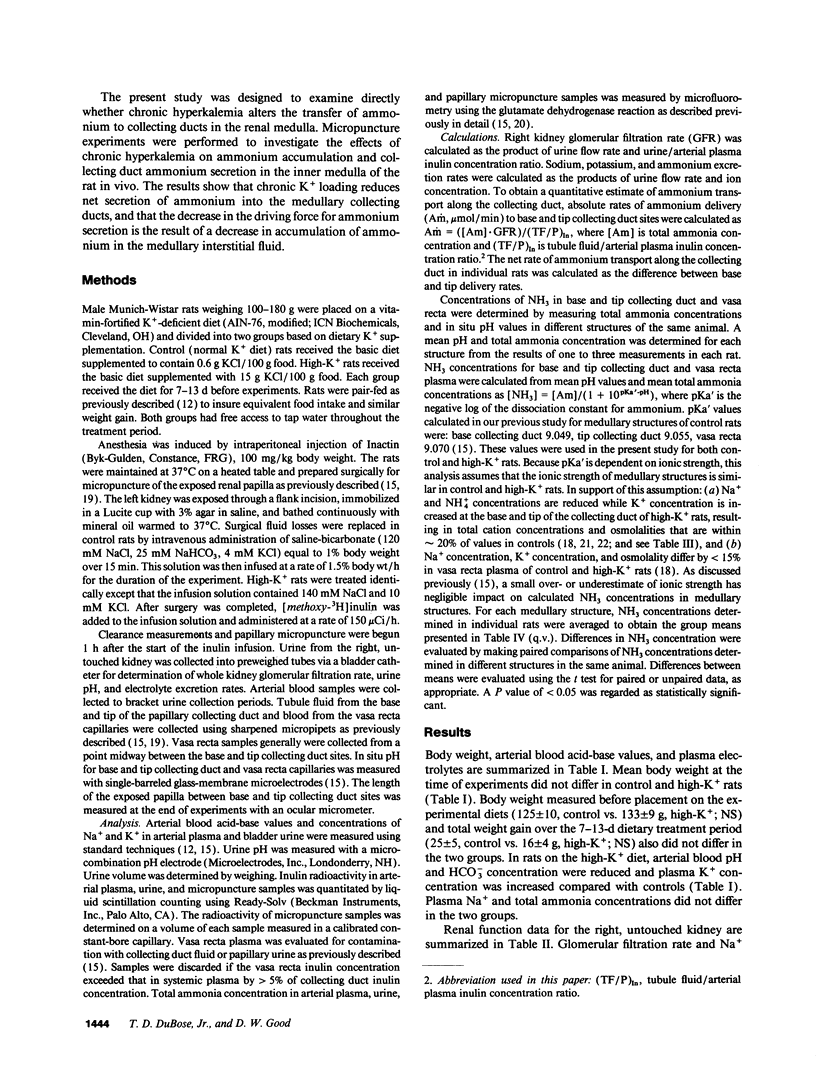
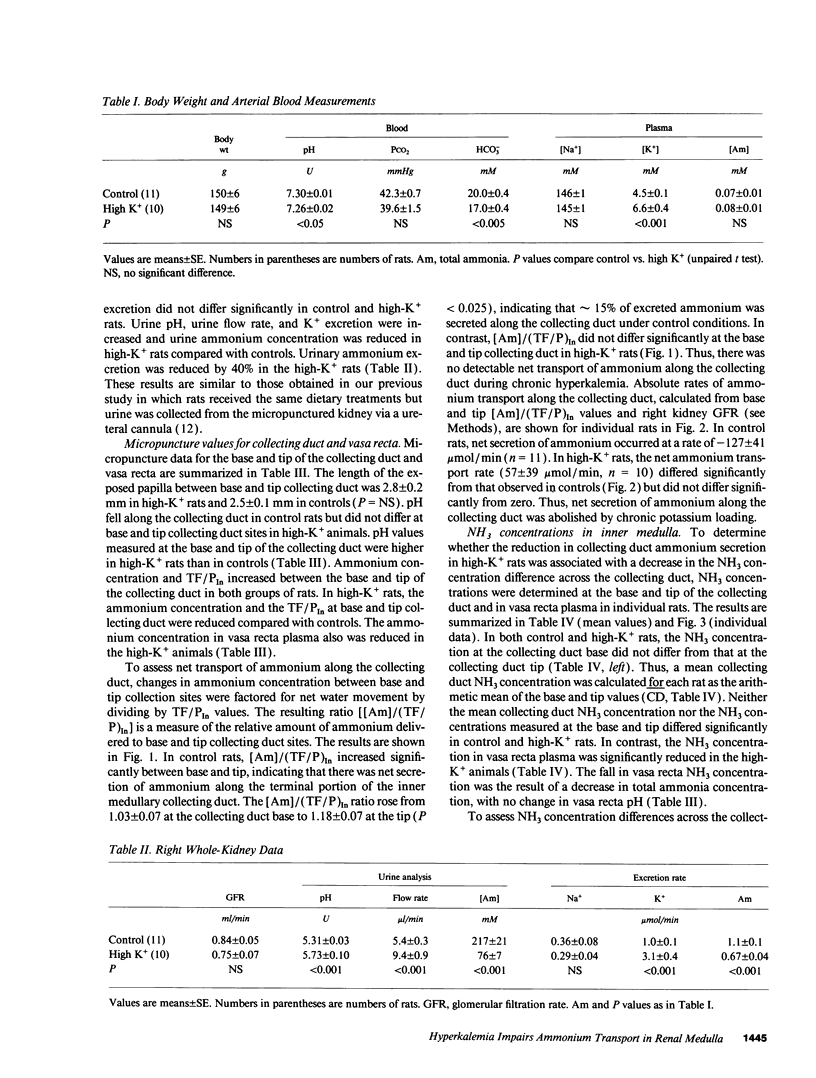
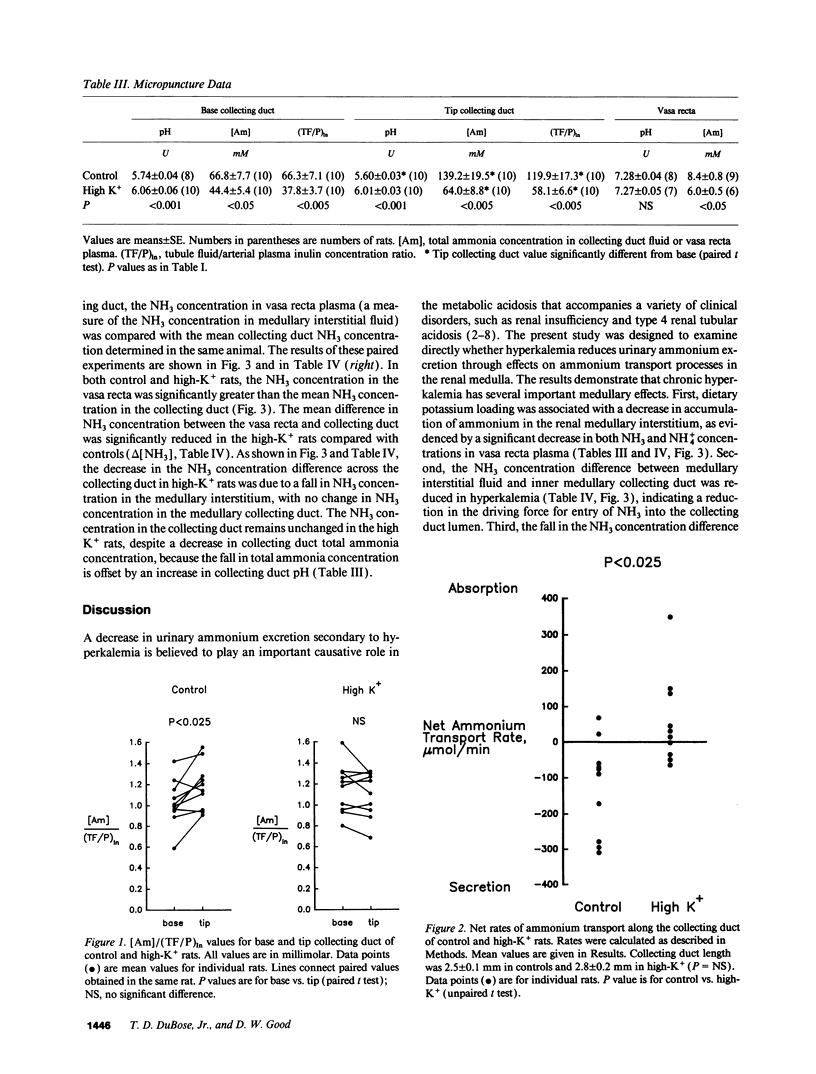
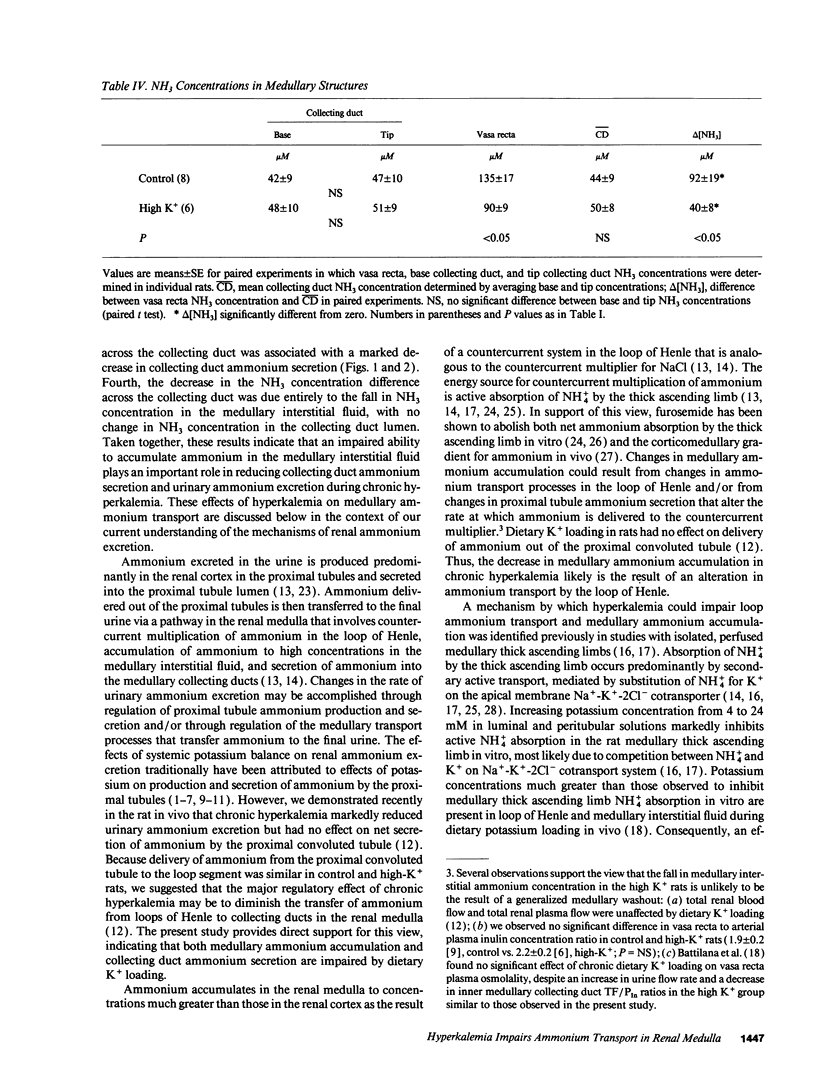
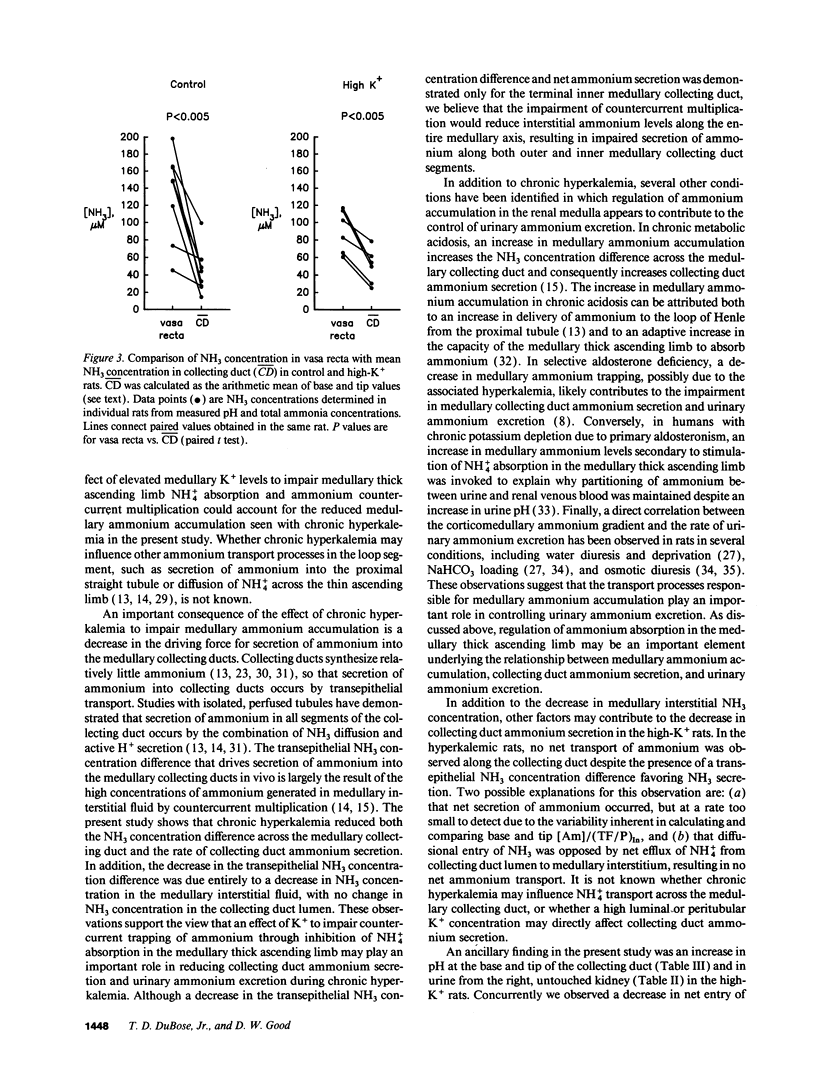
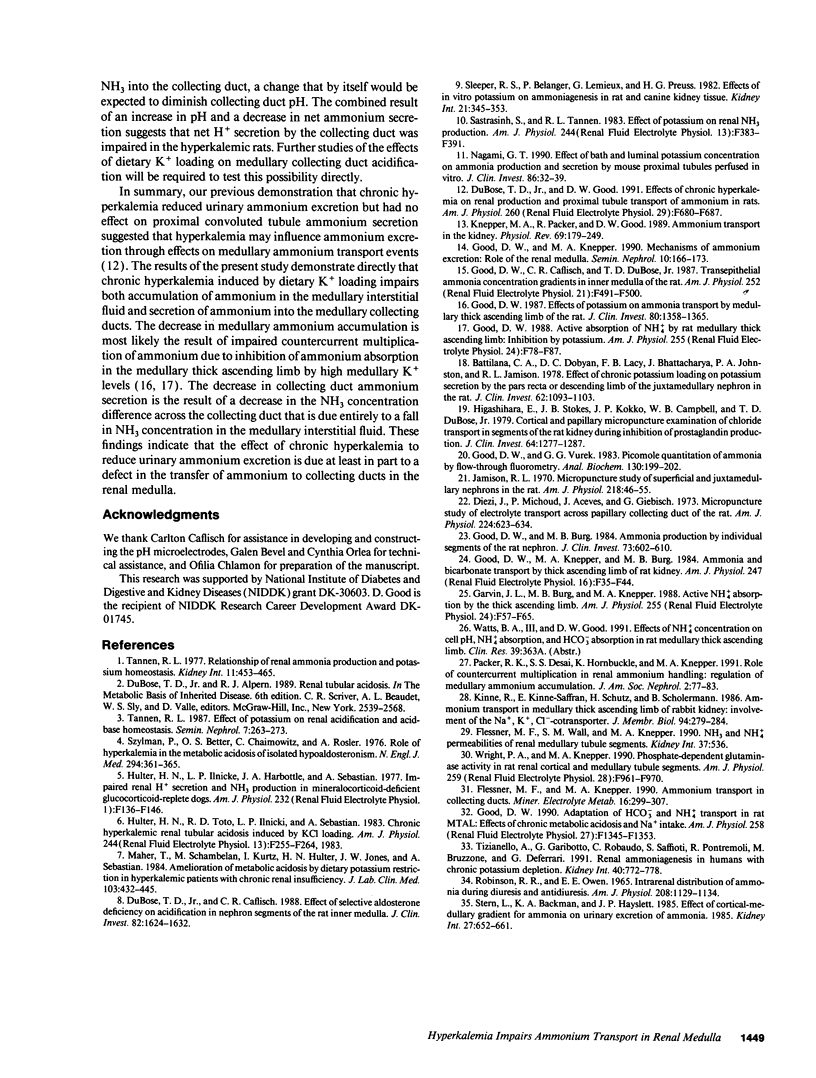
Selected References
These references are in PubMed. This may not be the complete list of references from this article.
- Battilana C. A., Dobyan D. C., Lacy F. B., Bhattacharya J., Johnston P. A., Jamison R. L. Effect of chronic potassium loading on potassium secretion by the pars recta or descending limb of the juxtamedullary nephron in the rat. J Clin Invest. 1978 Nov;62(5):1093–1103. doi: 10.1172/JCI109215. [DOI] [PMC free article] [PubMed] [Google Scholar]
- Diezi J., Michoud P., Aceves J., Giebisch G. Micropuncture study of electrolyte transport across papillary collecting duct of the rat. Am J Physiol. 1973 Mar;224(3):623–634. doi: 10.1152/ajplegacy.1973.224.3.623. [DOI] [PubMed] [Google Scholar]
- DuBose T. D., Jr, Caflisch C. R. Effect of selective aldosterone deficiency on acidification in nephron segments of the rat inner medulla. J Clin Invest. 1988 Nov;82(5):1624–1632. doi: 10.1172/JCI113774. [DOI] [PMC free article] [PubMed] [Google Scholar]
- DuBose T. D., Jr, Good D. W. Effects of chronic hyperkalemia on renal production and proximal tubule transport of ammonium in rats. Am J Physiol. 1991 May;260(5 Pt 2):F680–F687. doi: 10.1152/ajprenal.1991.260.5.F680. [DOI] [PubMed] [Google Scholar]
- Flessner M. F., Knepper M. A. Ammonium transport in collecting ducts. Miner Electrolyte Metab. 1990;16(5):299–307. [PubMed] [Google Scholar]
- Garvin J. L., Burg M. B., Knepper M. A. Active NH4+ absorption by the thick ascending limb. Am J Physiol. 1988 Jul;255(1 Pt 2):F57–F65. doi: 10.1152/ajprenal.1988.255.1.F57. [DOI] [PubMed] [Google Scholar]
- Good D. W. Active absorption of NH4+ by rat medullary thick ascending limb: inhibition by potassium. Am J Physiol. 1988 Jul;255(1 Pt 2):F78–F87. doi: 10.1152/ajprenal.1988.255.1.F78. [DOI] [PubMed] [Google Scholar]
- Good D. W. Adaptation of HCO-3 and NH+4 transport in rat MTAL: effects of chronic metabolic acidosis and Na+ intake. Am J Physiol. 1990 May;258(5 Pt 2):F1345–F1353. doi: 10.1152/ajprenal.1990.258.5.F1345. [DOI] [PubMed] [Google Scholar]
- Good D. W., Burg M. B. Ammonia production by individual segments of the rat nephron. J Clin Invest. 1984 Mar;73(3):602–610. doi: 10.1172/JCI111250. [DOI] [PMC free article] [PubMed] [Google Scholar]
- Good D. W., Caflisch C. R., DuBose T. D., Jr Transepithelial ammonia concentration gradients in inner medulla of the rat. Am J Physiol. 1987 Mar;252(3 Pt 2):F491–F500. doi: 10.1152/ajprenal.1987.252.3.F491. [DOI] [PubMed] [Google Scholar]
- Good D. W. Effects of potassium on ammonia transport by medullary thick ascending limb of the rat. J Clin Invest. 1987 Nov;80(5):1358–1365. doi: 10.1172/JCI113213. [DOI] [PMC free article] [PubMed] [Google Scholar]
- Good D. W., Knepper M. A., Burg M. B. Ammonia and bicarbonate transport by thick ascending limb of rat kidney. Am J Physiol. 1984 Jul;247(1 Pt 2):F35–F44. doi: 10.1152/ajprenal.1984.247.1.F35. [DOI] [PubMed] [Google Scholar]
- Good D. W., Knepper M. A. Mechanisms of ammonium excretion: role of the renal medulla. Semin Nephrol. 1990 Mar;10(2):166–173. [PubMed] [Google Scholar]
- Good D. W., Vurek G. G. Picomole quantitation of ammonia by flow-through fluorometry. Anal Biochem. 1983 Apr 1;130(1):199–202. doi: 10.1016/0003-2697(83)90670-x. [DOI] [PubMed] [Google Scholar]
- Higashihara E., Stokes J. B., Kokko J. P., Campbell W. B., DuBose T. D., Jr Cortical and papillary micropuncture examination of chloride transport in segments of the rat kidney during inhibition of prostaglandin production. Possible role for prostaglandins in the chloruresis of acute volume expansion. J Clin Invest. 1979 Nov;64(5):1277–1287. doi: 10.1172/JCI109583. [DOI] [PMC free article] [PubMed] [Google Scholar]
- Hulter H. N., Ilnicki L. P., Harbottle J. A., Sebastian A. Impaired renal H+ secretion and NH3 production in mineralocorticoid-deficient glucocorticoid-replete dogs. Am J Physiol. 1977 Feb;232(2):F136–F146. doi: 10.1152/ajprenal.1977.232.2.F136. [DOI] [PubMed] [Google Scholar]
- Hulter H. N., Toto R. D., Ilnicki L. P., Sebastian A. Chronic hyperkalemic renal tubular acidosis induced by KCl loading. Am J Physiol. 1983 Mar;244(3):F255–F264. doi: 10.1152/ajprenal.1983.244.3.F255. [DOI] [PubMed] [Google Scholar]
- Jamison R. L. Micropuncture study of superficial and juxtamedullary nephrons in the rat. Am J Physiol. 1970 Jan;218(1):46–55. doi: 10.1152/ajplegacy.1970.218.1.46. [DOI] [PubMed] [Google Scholar]
- Kinne R., Kinne-Saffran E., Schütz H., Schölermann B. Ammonium transport in medullary thick ascending limb of rabbit kidney: involvement of the Na+,K+,Cl(-)-cotransporter. J Membr Biol. 1986;94(3):279–284. doi: 10.1007/BF01869723. [DOI] [PubMed] [Google Scholar]
- Knepper M. A., Packer R., Good D. W. Ammonium transport in the kidney. Physiol Rev. 1989 Jan;69(1):179–249. doi: 10.1152/physrev.1989.69.1.179. [DOI] [PubMed] [Google Scholar]
- Maher T., Schambelan M., Kurtz I., Hulter H. N., Jones J. W., Sebastian A. Amelioration of metabolic acidosis by dietary potassium restriction in hyperkalemic patients with chronic renal insufficiency. J Lab Clin Med. 1984 Mar;103(3):432–445. [PubMed] [Google Scholar]
- Nagami G. T. Effect of bath and luminal potassium concentration on ammonia production and secretion by mouse proximal tubules perfused in vitro. J Clin Invest. 1990 Jul;86(1):32–39. doi: 10.1172/JCI114702. [DOI] [PMC free article] [PubMed] [Google Scholar]
- Packer R. K., Desai S. S., Hornbuckle K., Knepper M. A. Role of countercurrent multiplication in renal ammonium handling: regulation of medullary ammonium accumulation. J Am Soc Nephrol. 1991 Jul;2(1):77–83. doi: 10.1681/ASN.V2177. [DOI] [PubMed] [Google Scholar]
- ROBINSON R. R., OWEN E. E. INTRARENAL DISTRIBUTION OF AMMONIA DURING DIURESIS AND ANTIDIURESIS. Am J Physiol. 1965 Jun;208:1129–1134. doi: 10.1152/ajplegacy.1965.208.6.1129. [DOI] [PubMed] [Google Scholar]
- Sastrasinh S., Tannen R. L. Effect of potassium on renal NH3 production. Am J Physiol. 1983 Apr;244(4):F383–F391. doi: 10.1152/ajprenal.1983.244.4.F383. [DOI] [PubMed] [Google Scholar]
- Sleeper R. S., Belanger P., Lemieux G., Preuss H. G. Effects of in vitro potassium on ammoniagenesis in rat and canine kidney tissue. Kidney Int. 1982 Feb;21(2):345–353. doi: 10.1038/ki.1982.28. [DOI] [PubMed] [Google Scholar]
- Stern L., Backman K. A., Hayslett J. P. Effect of cortical-medullary gradient for ammonia on urinary excretion of ammonia. Kidney Int. 1985 Apr;27(4):652–661. doi: 10.1038/ki.1985.60. [DOI] [PubMed] [Google Scholar]
- Szylman P., Better O. S., Chaimowitz C., Rosler A. Role of hyperkalemia in the metabolic acidosis of isolated hypoaldosteronism. N Engl J Med. 1976 Feb 12;294(7):361–365. doi: 10.1056/NEJM197602122940703. [DOI] [PubMed] [Google Scholar]
- Tannen R. L. Effect of potassium on renal acidification and acid-base homeostasis. Semin Nephrol. 1987 Sep;7(3):263–273. [PubMed] [Google Scholar]
- Tannen R. L. Relationship of renal ammonia production and potassium homeostasis. Kidney Int. 1977 Jun;11(6):453–465. doi: 10.1038/ki.1977.63. [DOI] [PubMed] [Google Scholar]
- Tizianello A., Garibotto G., Robaudo C., Saffioti S., Pontremoli R., Bruzzone M., Deferrari G. Renal ammoniagenesis in humans with chronic potassium depletion. Kidney Int. 1991 Oct;40(4):772–778. doi: 10.1038/ki.1991.274. [DOI] [PubMed] [Google Scholar]
- Wright P. A., Knepper M. A. Phosphate-dependent glutaminase activity in rat renal cortical and medullary tubule segments. Am J Physiol. 1990 Dec;259(6 Pt 2):F961–F970. doi: 10.1152/ajprenal.1990.259.6.F961. [DOI] [PubMed] [Google Scholar]


